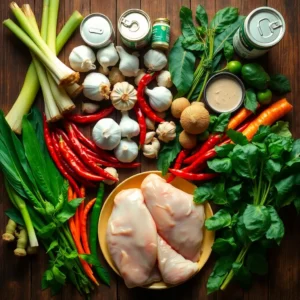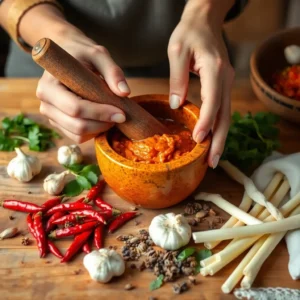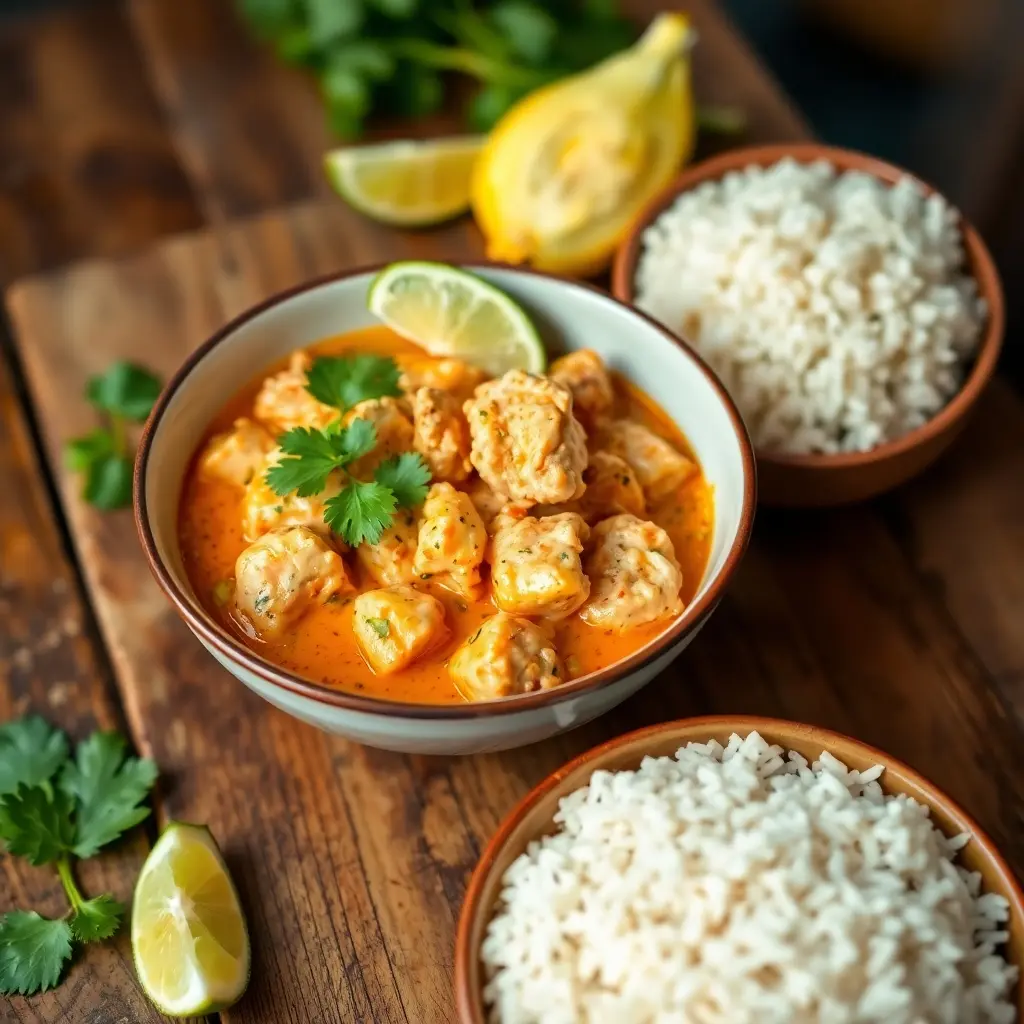Thai cuisine is a delightful tapestry of flavors, aromas, and textures, and few dishes exemplify this better than Thai chicken curry. Renowned for its perfect balance of sweet, spicy, salty, and tangy notes, this dish brings together the essence of Thai culinary tradition. Whether you’re a novice cook or a seasoned foodie, learning to make an authentic Thai chicken curry recipe at home can be both rewarding and fun. This article will guide you through every step, from selecting fresh ingredients to perfecting your curry paste, ensuring your final dish is nothing short of spectacular.
Part 1: Introduction to Thai Chicken Curry
The Essence of Thai Cuisine
Thai cuisine is celebrated globally for its harmonious blend of contrasting flavors. It’s not just food; it’s an art form that balances aromatic spices with creamy coconut milk and the heat of chilies. Thai chicken curry is a prime example of this balance, offering a flavorful experience that is both comforting and adventurous.
Popularity of Thai Chicken Curry Worldwide
This iconic dish has transcended its roots, becoming a favorite in kitchens across the globe. From street vendors in Bangkok to high-end restaurants in New York, the Thai chicken curry recipe is cherished for its versatility and ability to cater to various palates. With endless variations like green, red, and yellow curries, there’s a version for everyone.
Whether you’re looking to recreate a meal from your travels or just exploring new flavors, this recipe is your gateway to authentic Thai cuisine. And the best part? You can easily adapt it to your taste and dietary preferences.
Part 2: Ingredients for Thai Chicken Curry
Essential Proteins and Vegetables
 The heart of a Thai chicken curry recipe lies in its ingredients. First, you’ll need tender, juicy chicken, which can be boneless thighs or breasts, depending on your preference. While chicken is traditional, feel free to experiment with tofu or shrimp as substitutions! Moreover, vegetables like bell peppers, zucchini, and baby corn not only add color but also enhance the dish’s texture.
The heart of a Thai chicken curry recipe lies in its ingredients. First, you’ll need tender, juicy chicken, which can be boneless thighs or breasts, depending on your preference. While chicken is traditional, feel free to experiment with tofu or shrimp as substitutions! Moreover, vegetables like bell peppers, zucchini, and baby corn not only add color but also enhance the dish’s texture.
The use of fresh vegetables is crucial for achieving that authentic Thai flavor. Although frozen options might seem convenient, fresh produce ensures the curry is vibrant and full of life. Plus, a mix of red and green peppers adds both sweetness and crunch, making every bite exciting.
Key Spices and Herbs
Thai cuisine wouldn’t be the same without its signature blend of spices and herbs. From the earthy undertones of turmeric to the bright, citrusy notes of lemongrass, these components create a symphony of flavors. Galangal, similar to ginger, adds depth, while kaffir lime leaves bring a refreshing aroma.
Additionally, don’t skip on the fish sauce! This staple ingredient imparts a savory, umami-rich taste that ties the whole dish together. A dash of palm sugar balances the heat from the chilies, creating the perfect harmony of flavors that Thai curries are known for.
Importance of Fresh Ingredients
Freshness isn’t just a preference in Thai cooking—it’s a necessity. The vibrant flavors of herbs like basil and cilantro shine best when they’re fresh, not dried or wilted. Furthermore, using fresh coconut milk instead of canned elevates the creaminess and richness of the dish.
Whenever possible, shop for these ingredients at an Asian market, where you’ll likely find everything from lemongrass stalks to galangal. By ensuring the freshness of your ingredients, you’re already halfway to creating a curry that rivals your favorite Thai restaurant.
Part 3: Preparing the Curry Paste
Traditional vs. Store-Bought Curry Paste
When it comes to making a Thai chicken curry recipe, the curry paste is the foundation. While store-bought options are convenient, they rarely capture the depth of flavor you get from a homemade paste. Traditional curry paste, made from fresh ingredients, offers a level of authenticity that’s hard to replicate. However, if you’re short on time, opt for a high-quality store-bought paste from an Asian market to ensure your dish still packs a flavorful punch.
Step-by-Step Guide to Homemade Curry Paste
 Creating your own curry paste might seem daunting, but it’s surprisingly simple and incredibly rewarding. Start by gathering essential ingredients: red chilies, garlic, shallots, lemongrass, galangal, and kaffir lime zest. Add shrimp paste or a plant-based alternative for an umami kick.
Creating your own curry paste might seem daunting, but it’s surprisingly simple and incredibly rewarding. Start by gathering essential ingredients: red chilies, garlic, shallots, lemongrass, galangal, and kaffir lime zest. Add shrimp paste or a plant-based alternative for an umami kick.
Begin by toasting dry spices like coriander seeds and cumin in a hot skillet to release their aromas. Then, combine the toasted spices with the wet ingredients in a mortar and pestle or food processor. Gradually grind or blend them into a smooth paste. Although this requires patience, the robust and fresh flavors you achieve make the effort worthwhile.
Moreover, if you prefer a milder curry, reduce the number of chilies, or deseed them before blending. Taste your paste as you go, adjusting the saltiness or sweetness to suit your palate.
Tips for Achieving Authentic Flavor
Authenticity in a Thai chicken curry recipe isn’t just about the ingredients—it’s about how they’re handled. First, avoid over-blending your paste, as a little texture helps carry the flavors better. Second, don’t rush the process; take your time to ensure the ingredients meld beautifully.
If you’ve gone the extra mile to make homemade curry paste, store any leftovers in an airtight container. A small amount of oil on top will help preserve its freshness for weeks.
Part 4: Cooking the Thai Chicken Curry
Sautéing Techniques for Optimal Flavor
Once your curry paste is ready, it’s time to cook! Start by heating a bit of oil—ideally coconut oil—in a large skillet or wok. As soon as the oil is warm, add the curry paste and sauté it gently over medium heat. This step is crucial because it releases the rich aromas of the spices and intensifies their flavors. Make sure to stir frequently, as this prevents burning and ensures even cooking.
The moment the paste starts to darken and the oil separates from it, you’ll know it’s perfectly cooked. At this stage, add the chicken, coating it thoroughly in the fragrant paste. This allows the meat to absorb the robust flavors right from the start, creating a deeply flavorful base.
Incorporating Coconut Milk and Simmering
Next, pour in the coconut milk. This step transforms the curry into its creamy, luscious form, balancing the heat from the spices. Stir the mixture well, ensuring the paste dissolves completely into the coconut milk.
Once everything is blended, reduce the heat and let the curry simmer gently. Simmering allows the chicken to cook through while the flavors marry beautifully. Stir occasionally, and don’t forget to scrape the bottom of the pan to prevent sticking.
During this process, you can add vegetables like bell peppers or zucchini. Their natural sweetness complements the curry’s richness and adds a delightful crunch. Make sure not to overcook the vegetables; they should remain slightly crisp for the best texture.
Balancing Flavors: Sweet, Spicy, and Umami
Thai cuisine is all about balance, and this step is where you’ll fine-tune your curry’s flavor profile. Start by tasting the curry and adjusting as needed. Too spicy? Add a bit more coconut milk or sugar. Not salty enough? Add a splash of fish sauce.
While it’s easy to rely on measurements, trust your taste buds—they’re your best guide. You might also squeeze a little lime juice into the curry at the end to brighten the flavors.
By now, your Thai chicken curry recipe is nearly complete, and your kitchen is likely filled with its enticing aroma.
Part 5: Serving Suggestions and Accompaniments
Ideal Side Dishes: Jasmine Rice and Noodles
Serving your Thai chicken curry with the right accompaniment is just as important as cooking it well. While there are many options, fluffy jasmine rice is the traditional and most popular choice. Its light fragrance and slightly sticky texture perfectly complement the rich and creamy curry. For a more indulgent twist, try pairing the curry with Thai rice noodles, which soak up the flavorful sauce beautifully.
Alternatively, you could use brown rice or quinoa for a healthier take. These grains add a nutty flavor and an extra boost of fiber to your meal. Whatever you choose, ensure the side dish is warm and ready to serve as soon as the curry is finished. After all, timing is everything when it comes to enjoying this dish at its best.
Garnishing for Enhanced Presentation
A beautifully garnished curry is not just pleasing to the eyes but also enhances the eating experience. Sprinkle freshly chopped cilantro or Thai basil leaves on top of the curry for a burst of color and a refreshing aroma. Thinly sliced red chilies add a touch of heat and visual appeal, making the dish look as vibrant as it tastes.
For added texture, consider sprinkling roasted peanuts or crispy fried shallots over the curry. These elements provide a satisfying crunch that contrasts wonderfully with the smooth sauce. Additionally, serving lime wedges on the side allows your guests to customize the flavor to their liking.
Pairing with Beverages
Though beverages aren’t essential, they can elevate your dining experience. Thai iced tea, with its creamy sweetness, balances the spiciness of the curry beautifully. Alternatively, a cold, refreshing glass of coconut water can enhance the tropical essence of the meal.
Ultimately, how you serve your curry can significantly impact the overall experience. By pairing it with the right sides, garnishes, and drinks, you’ll transform your Thai chicken curry recipe into a meal that’s as memorable as it is delicious.
Part 6: Nutritional Information and Considerations
Calorie Count and Macronutrient Breakdown
Understanding the nutritional profile of your Thai chicken curry recipe helps you enjoy it guilt-free. A standard serving of Thai chicken curry with jasmine rice typically provides around 400–500 calories. This dish is a balanced mix of proteins, healthy fats, and carbohydrates, making it a wholesome meal.
The chicken supplies lean protein essential for muscle repair and overall health. Meanwhile, coconut milk contributes healthy fats that provide a creamy texture without compromising nutritional value. On the other hand, vegetables like bell peppers and zucchini are low in calories yet packed with vitamins and antioxidants.
Health Benefits of Key Ingredients
The ingredients in this dish aren’t just flavorful—they’re also incredibly nutritious. For example, turmeric, a key component in curry paste, contains curcumin, which has powerful anti-inflammatory properties. Similarly, ginger and galangal aid digestion and support the immune system.
Additionally, coconut milk is rich in medium-chain triglycerides (MCTs), which can boost energy levels and promote heart health. Lemongrass, often used in Thai curries, is another standout ingredient known for its detoxifying and antimicrobial benefits. By incorporating these elements, this dish not only delights the palate but also nourishes the body.
Adjustments for Dietary Restrictions
Adapting the Thai chicken curry recipe to fit dietary needs is easier than you might think. For a dairy-free option, simply confirm that your curry paste doesn’t contain any hidden dairy products. For a gluten-free version, ensure that the fish sauce and soy sauce are gluten-free, as some brands may contain wheat.
If you’re cooking for vegetarians or vegans, substitute the chicken with tofu or chickpeas and use a plant-based fish sauce alternative. Similarly, replacing coconut milk with a light coconut cream can lower the calorie content for those watching their intake.
By tailoring the recipe to suit different dietary preferences, you can make this beloved dish accessible to everyone at the table. Finally, in Part 7, we’ll address common questions about Thai chicken curry to help you master this recipe entirely!
Part 7: Frequently Asked Questions (FAQs)
How can I make the curry less spicy?
If the spiciness of your Thai chicken curry recipe feels overwhelming, there are several ways to tone it down. Adding more coconut milk is the easiest option, as it dilutes the heat while enhancing the dish’s creaminess. Alternatively, a small amount of sugar can help balance the spice. If you prefer, you can also reduce the number of chilies in the curry paste or use milder varieties like Kashmiri chilies.
Can I substitute chicken with other proteins?
Absolutely! While chicken is the traditional choice, this recipe is incredibly versatile. You can swap chicken for shrimp, tofu, or even fish fillets, depending on your dietary needs or preferences. For a plant-based alternative, chickpeas or hearty vegetables like sweet potatoes work wonderfully. Just ensure the cooking time matches the protein or substitute you choose to avoid overcooking.
What is the shelf life of homemade curry paste?
Homemade curry paste can last up to two weeks in the refrigerator if stored properly in an airtight container. Adding a thin layer of oil on top helps maintain its freshness by sealing out air. For longer storage, freeze the paste in small portions, such as ice cube trays, and use it as needed for future curries.
How do I store leftover Thai chicken curry?
Leftover Thai chicken curry can be stored in an airtight container in the refrigerator for up to three days. When reheating, use a low heat setting to avoid overcooking the chicken or causing the coconut milk to separate. If the curry thickens too much in the fridge, simply add a splash of water or coconut milk while warming it up.
Is it possible to make this curry vegan?
Yes, transforming this dish into a vegan version is straightforward. Replace chicken with tofu or jackfruit and use plant-based fish sauce alternatives. Ensure your curry paste does not contain shrimp paste, which is common in some store-bought options, and opt for a vegan-friendly brand or homemade paste.
What vegetables can I add to the curry?
The options for vegetables are almost endless. Bell peppers, zucchini, carrots, eggplant, and green beans are popular choices. Leafy greens like spinach or kale can also be added toward the end of cooking for extra nutrients. If you’re feeling adventurous, try adding pineapple chunks for a sweet and tangy twist.

